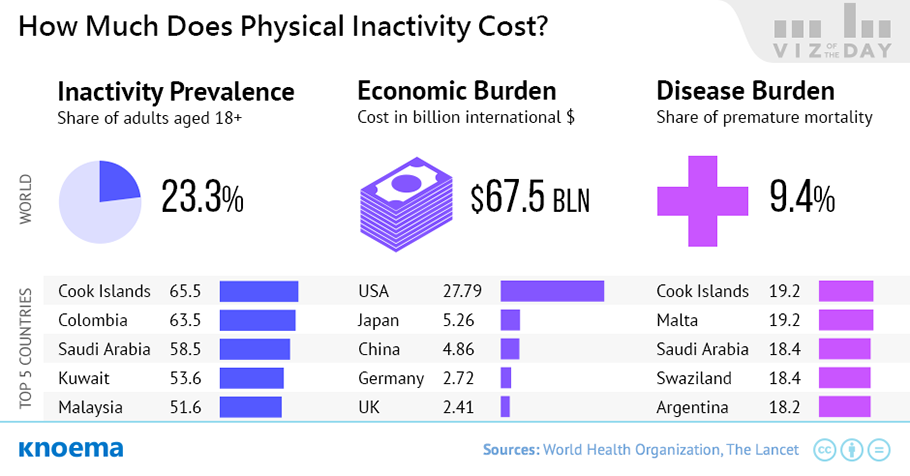Sedentary behavior has become increasingly common in modern society, resulting in a general decrease of physical activity worldwide. The World Health Organization (WHO) defines physical activity as any bodily movement including activities undertaken during leisure, work, home-based activities, and engaging in recreational pursuits. Increased urbanization, which generally increases air pollution, decreases the number of parks and sidewalks, and spurs high-density traffic, often discourages participation in physical activity. This is particularly concerning given that insufficient physical activity is one of ten leading risk factors - along with more commonly known risk factors such as smoking and obesity - for death and noncommunicable diseases, including cancer, cardiovascular diseases, and diabetes.
Research shows …
Eliminating physical inactivity could add 0.68 years to the life expectancy of the world's population, including active people, according to a 2012 study for the Lancet Physical Activity Series Working Group. In addition, 9 percent of premature deaths, or 3.3 of the 36 million deaths worldwide each year, could be averted if inactive people were to become active. For comparison, smoking caused about 5 million deaths globally in 2000.
- According to the WHO, in 2010, about 1 in 4 adults worldwide was insufficiently active, with an alarming 80 percent of the adolescent population aged 11-17 being insufficiently physically active.
- People in high-income countries tended to be more inactive given the pervasiveness of sedentary jobs and "passive" modes of transportation.
- Geographically, insufficient physical activity was most prevalent in the Americas and the East Mediterranean region. Regardless of the region, however, men were more active than women.
The billion dollar economic price tag
In addition to harming individuals, physical inactivity has real and increasingly measurable effects on the global economy. The economic burden of physical inactivity in 2013 was estimated at $67.5 billion worldwide, according to the recent research published in the Lancet journal. This is equivalent to the net worth of the world's second richest person or the GDP of Ethiopia. Total costs include direct health-care costs of $53.8 billion and productivity losses due to premature deaths of $13.7 billion. Economic and health burdens are distributed unequally across regions. Current economic costs are borne mainly in high-income countries given that these countries have more developed health and economic systems. Less developed countries pay more in terms of disease burden as they can least afford to implement social programs to address physical inactivity.
Physical activity yields healthier and more productive populations
Apart from the billions of dollars that could be saved to the world economy if levels of inactivity decrease, physical activity could help reduce the rates of coronary heart disease, stroke, high blood pressure, breast and colon cancer, depression, and other noncommunicable diseases. At least 150 minutes of moderate-intensity physical activity per week, such as walking, cycling or other sports, is considered to be sufficient for adults, according to the WHO.
Материалы по теме
9th Global Conference on Health Promotion
The 9th Global Conference on Health Promotion (9GCHP) will be co-organized by WHO and the National Health and Family Planning Commission (NHFPC) of the People's Republic of China. The conference will provide an unprecedented opportunity to reassert the significance of health promotion in improving health and health equity at the historical moment of 30 years anniversary of Ottawa Charter, and the first year of implementing the Sustainable Development Goals (SDGs). It will direct and guide Member States on the practical application of evidence-based health promotion concepts, approaches and mechanisms for achieving SDGs. Event...
